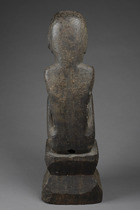Female "bulul" · Philippines - Ifugao · ID: 3040143
Description
wood, encrusted black patina, eyes with ceramic inlay, characteristic form, hole in the parting, sacrificial traces, slightly dam. (nose), missing part (right ear);
“bulul” are deities associated with the production of bountiful harvests, capable of miraculously increasing the rice before and after it is stored in the granary. The ritual sequence associated with the production of “bulul” images is long, elaborate, and requires considerable expenditure of resources. Ceremonies are held in every stage of production, a process which may take more than six weeks to complete. By reciting the “bulul” origin myth during ceremonies involving the activation of newly carved examples, the powers and benefits bestowed in the mythological past are transferred to the present. During activation ceremonies the “bulul” figures are bathed in the blood of a sacrificed pig, and at the conclusion of the ritual the figures are placed in the granary. They are usually made in pairs, one male and one female. They are inherited by the first child of the family, along with associated rice fields. The wood for “bulul” figure usually comes from the “narra” tree.





